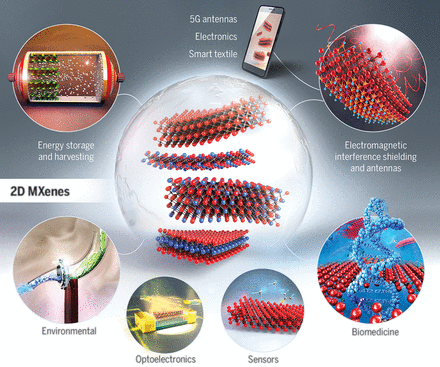A family of thin materials
Two-dimensional (2D) materials have attracted interest because of the unusual properties that emerge in these confined structures. There is a growing family of 2D metal carbides and nitrides known as MXenes that contain an odd number of layers in which metals (M) sandwich carbon or nitrogen (X) layers. VahidMohammadi et al. reviewed the progress in synthesizing this growing library of materials. Mixed-metal combinations can be used, as well as a range of surface terminations, making it possible to tune the properties. However, there are still challenges in improving the synthesis methods and developing techniques that can be scaled up.
Science, abf1581, this issue p. eabf1581
Structured Abstract
BACKGROUND
Appreciation of the fact that synthesis of two-dimensional (2D) materials does not necessarily require van der Waals bonded layered precursors led to discovery of many new materials, including MXenes—2D carbides and nitrides of transition metals, produced by selective etching of strongly bonded layered solids. Ti3C2 was first reported in 2011 and set the stage for synthesis of Ti2C, Ta4C3, and other MXenes from their MAX phase precursors, demonstrating three types of possible structures (M2X, M3X2, and M4X3). M5C4 was later produced, further increasing the structural diversity and bringing the number of theoretically possible compositions to more than 100, including those with in-plane and out-of-plane ordering of the metal atoms. Considering various surface terminations of MXenes, the number of distinct compositions increases by another order of magnitude. The ability of MXenes to form carbonitrides and solid solutions suggests a potentially infinite number of compositions and opens a new era of computationally driven atomistic design of 2D materials.
ADVANCES
MXenes add a large number of building blocks, mainly metallic conductors, to the family of 2D materials, most of which are dielectrics, semiconductors, or semimetals. By using tunable properties of MXenes, one can build devices ranging from transistors to supercapacitors, batteries, antennas, and sensors from 2D nanosheets by using additive manufacturing or other coating and processing techniques. MXenes have already shown a variety of electronic, optical, chemical, and mechanical properties, and the concept of MXetronics (all-MXene optoelectronics) has been proposed. High electronic conductivity allows their use in current collectors, interconnects, and conductive inks. MXenes possess electrochemically and chemically tunable plasmonic properties, with interband transitions and plasmon resonance peaks covering the entire ultraviolet, visible, and near-infrared range, which allow their electrochromic and photothermal therapy applications. Their strong interaction with electromagnetic waves from terahertz to gigahertz frequencies is used in electromagnetic interference shielding and communication. Redox activity of transition metal atoms on the MXene surface enables electrochemical energy storage in batteries and supercapacitors as well as electrocatalysis. Controlled spacing between the 2D sheets is used for separation of gases, water purification, and dialysis. The surface charge of MXenes allows aqueous processing without surfactants or binders as well as formation of liquid crystals. Organic molecules, polymers, and ions can be intercalated between MXene layers, allowing properties tuning and multilayer assemblies. Nontoxic and environmentally friendly titanium-based MXenes, built of abundant elements, and their hybrids and composites with polymers, ceramics, and metals are particularly attracting considerable attention.
OUTLOOK
While progress has been made on the preparation of carbide MXenes, synthesis of nitrides is trailing behind. Vapor phase synthesis is needed for integration of MXenes on chips using current microfabrication device technology. Large-scale, environmentally friendly synthesis methods are the key to wide use of MXenes in future additive manufacturing technologies. Precise control of the structure and surface chemistry, including defects and strain engineering, should pave the way to theoretically predicted intrinsically semiconducting, topologically insulating, and ferromagnetic MXenes as well as other discoveries in MXene physics and chemistry. Mechanically strong, environmentally stable, and highly conductive MXenes may have a major impact on flexible, printable, and wearable self-powered electronics. However, the use of MXenes in combination with other 2D materials to build heterostructures and devices by self-assembly from solution is perhaps the most exciting prospect.
The large number of MXene compositions having structures with three, five, seven, or nine atomic layers containing one or two kinds of metal atoms and various surface terminations (−F, =O, −Cl, −Br, etc.) have shown promising optoelectronic, mechanical, and electrochemical properties. They have found use in a wide range of applications ranging from energy storage and harvesting to catalysis, water purification and desalination, electromagnetic interference shielding, communication, optics, electronics, plasmonics, sensors, actuators, composites, and medicine.
” data-icon-position=”” data-hide-link-title=”0″>
The large number of MXene compositions having structures with three, five, seven, or nine atomic layers containing one or two kinds of metal atoms and various surface terminations (−F, =O, −Cl, −Br, etc.) have shown promising optoelectronic, mechanical, and electrochemical properties. They have found use in a wide range of applications ranging from energy storage and harvesting to catalysis, water purification and desalination, electromagnetic interference shielding, communication, optics, electronics, plasmonics, sensors, actuators, composites, and medicine.
Abstract
A decade after the first report, the family of two-dimensional (2D) carbides and nitrides (MXenes) includes structures with three, five, seven, or nine layers of atoms in an ordered or solid solution form. Dozens of MXene compositions have been produced, resulting in MXenes with mixed surface terminations. MXenes have shown useful and tunable electronic, optical, mechanical, and electrochemical properties, leading to applications ranging from optoelectronics, electromagnetic interference shielding, and wireless antennas to energy storage, catalysis, sensing, and medicine. Here we present a forward-looking review of the field of MXenes. We discuss the challenges to be addressed and outline research directions that will deepen the fundamental understanding of the properties of MXenes and enable their hybridization with other 2D materials in various emerging technologies.

